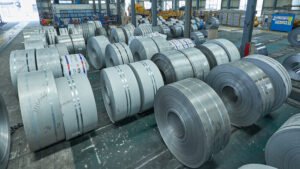Как складская программа MFY сокращает время выполнения заказа для глобальных покупателей листов из нержавеющей стали

Are your project timelines constantly threatened by unpredictable stainless steel sheet deliveries? This uncertainty can halt production, inflate your budget, and erode the trust your clients have in you. Our innovative stock program at MFY directly confronts this challenge, providing you with the materials you need, precisely when you need them.
MFY’s stock program significantly reduces lead times for global stainless steel sheet buyers by maintaining a vast, ready-to-ship inventory of common grades and specifications. This preempts production queues and shipping uncertainties, enabling faster order fulfillment and more reliable project scheduling for our international clients across various industries.
These delays aren't just minor inconveniences; they represent a fundamental weakness in the traditional global supply chain. For years, I’ve spoken with clients who feel powerless, caught between volatile mill schedules and unpredictable shipping lanes. It’s a reactive way to do business, and it’s no longer sustainable. That's why we shifted our focus from simply selling steel to providing a logistics solution.
The problem runs deeper than a single late shipment. It’s about the cumulative impact of uncertainty on a business’s health. When you can’t rely on your material lead times, you’re forced to carry expensive "just-in-case" inventory, tying up capital that could be used for growth. Or, you risk stockouts that bring your entire operation to a standstill. At MFY, we believe there's a better way. We’ve moved beyond the old model to create a system that offers our partners predictability and agility in a market that often has neither. Let’s explore the challenges and solutions in more detail.
What challenges do global buyers face in terms of lead time for stainless steel sheets?
Are you constantly juggling tight project deadlines, only to have them derailed by material delays? When your листы нержавеющей стали1 are late, it triggers a costly domino effect across your entire operation, frustrating your team and your customers. Understanding these challenges is the first step toward building a more resilient supply chain.
Global buyers face significant challenges with lead times, including production stoppages, increased project costs, and the inability to commit to client deadlines. These issues stem from unpredictable mill schedules, shipping delays, and complex customs procedures, creating major operational risks for their businesses.
These challenges aren’t abstract concepts; they have real-world consequences that I see every day. A valued client of ours in India, an engineering firm specializing in fabricating equipment for the food processing industry, once shared their immense frustration. They were consistently winning contracts based on their design expertise, but their reputation was suffering due to supply chain failures that were completely out of their control. A two-week delay in receiving 316L stainless steel sheets2 could postpone a project by over a month, leading to penalty clauses being triggered and, more importantly, a loss of trust with their end-customers. They were trapped in a cycle of apologizing for issues they didn't create. This story is not unique. It’s a narrative I’ve heard from distributors in Southeast Asia, construction contractors in the Middle East, and equipment integrators in Russia. The core problem is universal: a traditional supply chain model that is too rigid and opaque for the demands of modern global business. This forces companies into a defensive posture, eroding profitability and competitive standing. It’s this widespread pain point that motivated us at MFY to fundamentally rethink our role as a supplier.

The ripple effects of inconsistent lead times extend far beyond the initial delivery date, impacting a company's financial stability, market reputation, and operational efficiency. These are not isolated incidents but systemic risks that can undermine an otherwise successful business. Critically analyzing these impacts reveals just how integral a reliable supply chain is to sustainable growth. At MFY, we have built our entire stock program around mitigating these very risks for our clients.
The Financial Domino Effect of Production Halts
When a shipment of stainless steel sheets is delayed, the most immediate impact is on the production floor, but the financial consequences start accumulating instantly. The first hit comes from direct labor costs; skilled workers and machine operators are left idle, yet their wages must still be paid. A study from a leading manufacturing association recently estimated that unplanned downtime can cost a mid-sized fabrication plant anywhere from $10,000 to $25,000 per hour, depending on the scale of the operation. This doesn't even account for the cost of rescheduling production runs, which can disrupt the workflow for other projects, creating a cascade of inefficiency.
Beyond the direct costs, there are significant indirect financial burdens. Let's return to our client in India. When their food processing equipment project was delayed, they faced contractual penalties for late delivery, directly eroding their profit margin. Furthermore, their working capital was negatively impacted. They had already invested in other components for the project, and these assets were now sitting idle on their books, not generating revenue. This ties up cash flow, limiting the company's ability to invest in new opportunities or manage other operational expenses.
The financial strain is exacerbated by the volatility of the steel market itself. If a buyer is forced to find an alternative, last-minute supplier to meet a deadline, they will almost certainly pay a premium. This spot-market pricing is often significantly higher than contracted rates. This scenario turns procurement into a reactive, budget-breaking exercise rather than a strategic function. It creates a vicious cycle where project profitability is constantly under threat from supply chain instability.
Reputational Damage and Loss of Competitive Edge
Perhaps even more damaging than the immediate financial costs is the long-term erosion of a company's reputation. In today's competitive global market, reliability is a key differentiator. A single failure to deliver on time can permanently damage a hard-won client relationship. The end-customer, who was relying on our Indian client’s equipment, doesn't care about mill schedules or port congestion; they only know that their project is delayed. This loss of trust can lead to the loss of future contracts, not just with that client but with others in the industry who hear about the reliability issues.
This directly impacts a company's competitive edge. A business that can confidently promise and meet a 6-week delivery timeline will consistently win against a competitor that can only offer a vague 10-to-14-week window. Our client in India found themselves in this exact position. They were bidding against firms that may have had a local, albeit more expensive, stock of materials. By being unable to guarantee a delivery date, they were perceived as the riskier partner, even if their engineering and pricing were superior.
This creates a strategic disadvantage. Companies become hesitant to bid on large, time-sensitive projects, effectively limiting their own growth. They are stuck serving a smaller segment of the market that can tolerate longer lead times, which is often more crowded and less profitable. The ability to scale and take on more ambitious projects is directly tied to the predictability and reliability of the supply chain that supports it.
The Complexity of Inventory Management with Unreliable Timelines
Faced with unpredictable lead times, buyers are forced into a difficult balancing act with inventory. The traditional response is to maintain a large "safety stock" of essential materials like stainless steel sheets. While this can buffer against some delays, it introduces a host of new costs and complexities. This strategy, often called "Just-in-Case" inventory, is a direct reaction to an unreliable supply chain and is fundamentally inefficient.
The most obvious cost is the capital tied up in holding excess steel. This is working capital that is not earning a return. For a material like stainless steel, this can represent a significant financial burden. Furthermore, there are physical carrying costs, including warehousing space, insurance, and security. The steel must also be managed to prevent damage or degradation over time, adding labor and administrative overhead. The table below illustrates the trade-offs:
| Inventory Strategy | Key Advantages | Key Disadvantages & Associated Costs |
|---|---|---|
| Just-in-Time (JIT) | Low inventory holding costs, high capital efficiency. | Highly vulnerable to supply chain disruptions, risk of stockouts and production halts. |
| Just-in-Case (Safety Stock) | Buffer against delays, higher production continuity. | High capital investment, warehousing costs, risk of material obsolescence, insurance/security costs. |
| Vendor-Managed Inventory (VMI) | Reduced buyer-side management, optimized stock levels. | Requires deep integration and trust with supplier, potential loss of direct control. |
This inventory dilemma creates a no-win situation for many buyers. If they don't hold enough stock, they risk catastrophic production stoppages. If they hold too much, they sacrifice profitability and agility. This is precisely the problem MFY's stock program is designed to solve—by acting as our clients' reliable, off-site warehouse, we enable them to operate closer to a Just-in-Time model without the associated risks, freeing up their capital and resources.
MFY reduces lead timesПравда
MFY's stock program maintains ready-to-ship inventory to bypass production queues and shipping delays.
Delays only affect productionЛожь
Late shipments trigger financial penalties, reputational damage, and inventory management challenges beyond just production impacts.
What causes delays in stainless steel sheet delivery around the globe?
Ever feel like you're in the dark about why your stainless steel shipment is delayed again? The reasons can feel like a black box, ranging from mill capacity and raw material shortages to port congestion on the other side of the world. Let’s shed some light on the common culprits behind these frustrating delays.
Delays in global stainless steel sheet delivery are caused by a combination of factors. These include fluctuating raw material availability, lengthy mill production queues, volatile international shipping logistics, unforeseen port congestion, and complex, time-consuming customs clearance procedures in different countries.
Understanding the sources of these delays is critical because it highlights how many variables are outside a buyer's direct control. For years, my clients have expressed frustration, feeling that their meticulously planned projects were at the mercy of opaque external forces. A manufacturing head from a large fabrication plant in Southeast Asia once told me, "Cosmos, it’s not just one thing. One month, it’s a nickel price spike3 that pushes back the mill’s schedule. The next, our container is stuck in a port for three weeks because of a local labor dispute. We are constantly reacting." This feeling of helplessness is a common thread. It underscores the inherent fragility of a long-distance supply chain that relies on a linear, sequential process. Each stage—from raw material sourcing to final delivery—presents a potential failure point. Recognizing that these aren't isolated excuses but systemic issues is the first step toward appreciating why a fundamental shift in procurement strategy, like leveraging a ready-stock program, is not just a convenience but a competitive necessity for any company operating on the global stage.

The journey of a stainless steel sheet from its conception at a steel mill to its arrival at a buyer's facility is a long and complex process, fraught with potential chokepoints. These delays are rarely due to a single cause but are more often the result of a chain reaction of interconnected issues. A critical examination of these factors reveals weaknesses in the traditional global trade model, which MFY’s stock program is specifically designed to circumvent.
From Mine to Mill: The Upstream Bottlenecks
The production of stainless steel itself is the first major source of potential delays. Steel mills don't operate like a simple factory; they run massive, continuous campaigns for specific grades and thicknesses. A buyer's order for 304-grade sheets must wait for the mill to schedule a production run for that specific product, which can take weeks or even months depending on demand. This is the "production queue4" that buyers find so frustrating. A delay here has a direct knock-on effect on the entire timeline.
This scheduling is further complicated by the volatile market for raw materials. Stainless steel production is heavily dependent on nickel and chromium. As I've seen countless times, a sudden spike in the price of nickel, or a disruption in its supply from a major producing country, can cause mills to postpone production of certain nickel-bearing grades (like the popular 300 series) as they wait for prices to stabilize. For example, in early 2022, nickel prices on the London Metal Exchange (LME) saw unprecedented volatility, leading many mills to halt order acceptance for austenitic grades, causing massive delays for buyers globally.
Furthermore, mills themselves face operational challenges. Unscheduled maintenance, energy supply issues (as power costs can be a significant portion of production expenses), or labor shortages can all reduce a mill's output and extend the production queue for every customer waiting in line. For a buyer in India or the Middle East sourcing from China, these upstream issues are thousands of miles away but have a direct and significant impact on their project timeline.
The Black Box of International Freight
Once the stainless steel sheets are finally produced and packaged, they enter the second major stage of uncertainty: international logistics5. The global shipping industry is a complex ecosystem where a small disruption can have outsized consequences. A primary issue in recent years has been vessel and container availability. During periods of high demand, securing a slot on a container ship can be intensely competitive, leading to rolled bookings where cargo is bumped to a later sailing.
Port congestion is another critical bottleneck. I recall a period when major ports in both Asia and the destination markets were experiencing severe backlogs due to a combination of high import volumes and local labor shortages. A client in Russia saw their shipment of stainless steel sheets sit on a vessel offshore for nearly four weeks, waiting for a berth to open up. These delays are entirely unpredictable and can add a month or more to the standard transit time. According to a report by Sea-Intelligence, a maritime analytics firm, vessel schedule reliability has hovered at historic lows in recent years, sometimes with less than 40% of ships arriving on time.
The complexity doesn't end once the ship docks. Unloading, yard management, and transferring the container for inland transit all present opportunities for further delays. Damage to a container, mislaid paperwork, or a simple shortage of truck drivers to move the container from the port to a railhead or warehouse can add days or even weeks of frustrating, non-transparent delays to the journey.
Navigating the Gauntlet of Customs and Tariffs
The final hurdle before a buyer can take possession of their material is customs clearance6, a process that can be both complex and time-consuming. Every country has its own set of import regulations, documentation requirements, and inspection procedures. A minor error or omission on the commercial invoice, bill of lading, or certificate of origin can result in the entire shipment being flagged for a detailed inspection.
For our clients in markets like India or Southeast Asia, this is a significant point of anxiety. These inspections can be lengthy, and the shipment is held in a bonded warehouse during this time, incurring storage fees. I worked with a construction contractor who had a large order of stainless steel sheets held up because the HS (Harmonized System) code on the paperwork was disputed by the local customs authority. Resolving this discrepancy took over two weeks of back-and-forth communication, delaying a critical phase of their construction project.
Furthermore, the landscape of tariffs and trade duties is constantly shifting. A government may impose new anti-dumping duties or change import tax rates with little warning. This not only adds unexpected costs but can also trigger additional scrutiny and paperwork requirements at the border. For a buyer, navigating this gauntlet requires significant expertise and can still result in unforeseen delays that are entirely outside of their control, making a mockery of any carefully planned project schedule.
Nickel price spikes delay stainless steel productionПравда
Volatility in nickel prices (a key raw material) causes mills to postpone production of nickel-bearing grades like 304 stainless steel, creating delays.
Customs clearance is always fast and predictableЛожь
Customs procedures are often lengthy and unpredictable due to documentation errors, inspections, and changing tariff regulations, causing significant delays.
How does MFY’s stock program address these lead time issues?
Are you tired of hearing the same supply chain excuses for why your materials are late? The constant uncertainty makes effective planning feel impossible and puts your entire business at risk. MFY's stock program was built to bypass these traditional chokepoints, offering you control and predictability.
MFY’s stock program addresses lead time issues by decoupling procurement from the unpredictable mill production cycle. By maintaining a large, diverse inventory of ready-to-ship stainless steel sheets, we eliminate production waits and can dispatch orders almost immediately, directly counteracting logistical and manufacturing delays.
The core principle behind our stock program is simple but powerful: we absorb the upstream uncertainties so that our clients don’t have to. Instead of placing an order and then waiting for the mill to produce it and for a vessel to ship it, our clients are effectively buying from a pre-vetted, strategically located inventory. I remember the exact moment this clicked for our Indian client, Precision Engineering. They had just lost a bid because their 12-week lead time from a traditional mill was too long. Frustrated, they called me. I walked them through our live inventory portal7. They could see the exact quantity of 316L sheets they needed, available for immediate dispatch from our warehouse. Their next order was placed through our stock program. We shipped the material within 72 hours. While sea transit still took time, they received their steel in just under four weeks. This single experience transformed their business. They moved from a position of hoping for the best to a position of strategic control over their supply chain. It’s not just about having stock; it's about having the right stock, supported by a seamless digital interface and a logistics team dedicated to rapid export delivery.
Our stock program is not merely a warehouse filled with steel; it is a comprehensive, data-driven ecosystem8 designed to inject agility and predictability into our clients' supply chains. It fundamentally changes the procurement paradigm from a lengthy, linear process to an on-demand service. By critically analyzing the traditional failure points, we've built a solution that directly counters them, providing a buffer that empowers our clients.
The Strategic Advantage of a Pre-Positioned Inventory
The foundation of our program is a vast and diverse physical inventory. Unlike a steel mill that produces to order, we produce and procure for stock. This is a crucial distinction. We use market intelligence and data analytics, drawing on demand trends from our key export markets in India, Southeast Asia, and the Middle East, to forecast which grades, finishes, and thicknesses will be most needed. This means we invest our capital to stock high-demand products like 304, 316L, and 430 stainless steel sheets до our clients even place an order. This immediately eliminates the single longest part of the traditional lead time: the mill production queue.
This pre-positioned inventory acts as a powerful buffer against upstream volatility. When nickel prices fluctuate or a mill has an unexpected shutdown, our clients are insulated from the immediate impact because the material they need is already in our possession. I’ve personally guided manufacturing clients through market shocks where mill lead times extended to over 20 weeks, yet we were able to fulfill their orders from our stock in a fraction of that time.
Furthermore, our integrated supply chain, from our own cold-rolled processing and tube manufacturing facilities, gives us a unique advantage in replenishing this stock efficiently. We aren't just buying from other mills; we are a producer. This allows us to maintain high levels of stock availability and quality control, ensuring that the material is not only available but also meets the rigorous international standards our clients—from construction contractors to equipment integrators—demand.
Integrating Digital Tools for Real-Time Visibility
A physical inventory is only as good as the system that manages it. A key pillar of our stock program is our proprietary digital platform, which provides our clients with unprecedented transparency and control. This is a direct response to the "black box" of traditional procurement, where buyers often have little to no visibility of their order's status between placement and delivery. As part of our commitment to digital innovation, we’ve developed a client portal that is a game-changer.
Through this platform, our partners can view our real-time stock levels for various stainless steel sheet products 24/7. They can filter by grade, thickness, and finish, confirm quantities, and receive an instant quote. This transforms procurement from a multi-day process of emails and phone calls into a task that can be completed in minutes. This speed on the administrative side is crucial, as it allows our clients to make faster decisions and commit to their own customers with confidence.
Once an order is placed, that same digital platform provides end-to-end tracking. Clients can see when their order has been prepared, when it has been dispatched to the port, the vessel details, and its estimated time of arrival. This visibility is empowering. It removes the anxiety of the unknown and allows their logistics and project teams to plan with precision for the material's arrival. This blend of physical assets and digital innovation is at the heart of MFY's competitive strength.
A Case Study in Agility: The Precision Engineering Turnaround
The true value of our stock program is best illustrated through a client's success. Let's return to our client, Precision Engineering in India. They were tasked with building a set of high-purity mixing tanks for a pharmaceutical company, a project with a very strict deadline. Their usual supplier quoted them a 14-week lead time for the required 316L sheets, which would have made it impossible to meet the client's timeline.
Facing the loss of a high-value contract, their procurement manager logged into the MFY stock portal. They located the exact specification and quantity of 316L sheets they needed. Within two hours, the order was confirmed. Our logistics team had the material packed and dispatched to the port of loading in under three days. The total time from order placement to the material arriving at their facility near Mumbai was just 26 days. This allowed them to not only meet their deadline but to finish ahead of schedule, delighting their end-customer.
This experience fundamentally changed their business model. They now use our stock program for all their standard material needs, enabling them to bid on more time-sensitive, higher-margin projects. The table below provides a clear comparison of their experience:
| Procurement Metric | Traditional Mill Order | MFY Stock Program |
|---|---|---|
| Quotation & Order Time | 2-4 business days | < 2 hours |
| Production Queue Time | 8-10 weeks | 0 (Eliminated) |
| Dispatch Time | 1-2 weeks | < 3 days |
| Total Lead Time | 12-16 weeks | 3-4 weeks |
| Supply Chain Visibility | Low (Opaque) | High (Real-time tracking) |
| Planning Confidence | Низкий | Высокий |
This is the tangible impact of our program: we empower our clients with the speed and agility to win in their respective markets.
MFY's stock program eliminates mill production waitsПравда
By maintaining ready-to-ship inventory, MFY bypasses the traditional mill production cycle, allowing immediate dispatch.
MFY's program relies solely on third-party millsЛожь
MFY has its own cold-rolled processing and tube manufacturing facilities, allowing direct control over inventory quality and replenishment.
What are the benefits of MFY’s stock program for international buyers?
Are you simply looking for a faster delivery, or are you looking for a true competitive advantage? While speed is important, a supply solution that only saves time might hide other costs or compromises. The benefits of our stock program extend far beyond rapid delivery, positively impacting your entire business operation.
The benefits of MFY’s stock program for international buyers are multifaceted. They include drastically reduced lead times for better project planning, enhanced supply chain stability, reduced inventory holding costs for the buyer, and greater flexibility to respond to urgent or fluctuating market demands.
When I discuss our stock program with prospective clients, I always emphasize that we are not just selling stainless steel sheets; we are providing a strategic capability. The most profound benefit is the shift from a reactive to a proactive business posture. Imagine having the confidence to bid on a lucrative, fast-turnaround project that your competitors can't touch because they are constrained by 12-week lead times. This is what our program delivers. A distributor partner in the Middle East recently used our stock to secure a major government infrastructure contract9. They were the only bidder who could guarantee material delivery within 30 days. This is not just a sale; it is a strategic victory enabled by supply chain design. The benefits cascade through the organization. The finance department sees improved cash flow as less capital is tied up in safety stock. The project management team can create more reliable timelines, improving labor efficiency. The sales team is empowered to pursue new market opportunities. It's a holistic improvement that strengthens the entire enterprise, making it more resilient, agile, and profitable.

The advantages of leveraging a well-managed stock program like MFY's create a powerful ripple effect, transforming a company's operational capabilities and financial health. These benefits are not just theoretical; they are tangible, measurable outcomes that give our clients a distinct and sustainable competitive edge in their markets. By moving procurement from a cost center plagued by uncertainty to a strategic enabler of growth, the program redefines what's possible.
Financial Gains: Improving Cash Flow and Profitability
One of the most significant benefits for any international buyer is the immediate improvement in working capital management. By relying on MFY's stock, our clients can drastically reduce or even eliminate their own "just-in-case" safety inventory. Holding stock is expensive; the capital tied up in tons of steel sitting in a warehouse is capital that cannot be used for innovation, marketing, or business expansion. Let’s consider a simple scenario: a distributor holding $500,000 worth of safety stock. With a conservative cost of capital at 8%, that inventory costs them $40,000 annually, not including physical warehousing, insurance, and management costs. Our stock program effectively allows them to outsource this financial burden.
This improved cash flow has a direct impact on profitability10. Freed-up capital can be deployed to more productive areas of the business. Furthermore, by avoiding the premium prices of last-minute spot market purchases when faced with a stockout, our clients maintain better control over their project cost of goods sold (COGS). Predictable material costs lead to more accurate project bidding and healthier profit margins.
I have seen this firsthand with a manufacturing client who was able to use the capital they freed up from inventory reduction to invest in a new piece of automated machinery. This investment increased their production efficiency, further boosting their profitability. The financial benefits are a virtuous cycle: leveraging our stock frees up capital, which fuels investment in efficiency, which in turn improves the bottom line.
Operational Superiority: Predictability and Planning
Beyond the balance sheet, the operational benefits are profound. The single greatest operational advantage is predictability. When a project manager knows that their stainless steel sheets will arrive within a reliable 4-week window, they can plan with a level of precision that is impossible with a volatile 12-to-16-week lead time. This has a dramatic effect on overall efficiency.
Firstly, labor and machine scheduling can be optimized. There is no more costly downtime with crews waiting for materials to arrive. Production runs can be planned back-to-back, maximizing the utilization of expensive equipment. Our client, Precision Engineering, reported a 15% increase in overall plant productivity in the year after they switched to our stock program, simply because they eliminated the dead time between projects caused by material delays.
Secondly, this predictability enhances the entire project management process. Timelines become more credible, milestones are met more consistently, and communication with the end-customer is improved. This builds trust and reinforces the company's reputation for reliability. For construction contractors, this is paramount. Being able to accurately forecast the arrival of steel allows them to coordinate all other aspects of the build, from foundation work to coordinating other subcontractors, creating a smoother, faster, and more cost-effective construction process.
Market Responsiveness: Seizing Opportunities
In a fast-moving global economy, the ability to react quickly is a powerful competitive weapon. MFY's stock program endows our clients with a newfound market agility. When a competitor is waiting for a mill run, our clients are already fabricating and delivering. This allows them to seize opportunities that are simply out of reach for companies reliant on traditional supply chains.
Consider the case of an equipment integrator who receives an urgent request from a major client. The project requires a specific grade of stainless steel sheet, and the timeline is tight. Using our stock program, the integrator can confirm material availability and quote a delivery time that is weeks or even months shorter than their competitors. This ability to say "yes" to rush jobs not only wins the immediate contract but also positions them as a highly responsive and valuable partner for the future.
This responsiveness also allows our clients to be more resilient to market shifts. If demand for one of their products suddenly surges, they can quickly procure the necessary raw materials from our stock to ramp up production. Conversely, because they aren't holding massive amounts of their own inventory, they are less exposed if demand for a certain product line suddenly drops. They are not left with obsolete stock of a specific steel grade. This flexibility, this ability to pivot quickly, is a hallmark of a modern, resilient enterprise, and it's a direct benefit of having MFY as a strategic inventory partner.
Stock programs reduce lead timesПравда
MFY's stock program drastically cuts lead times, enabling better project planning and faster response to market demands.
Stock programs increase inventory costsЛожь
MFY's stock program reduces buyers' inventory holding costs by outsourcing safety stock, improving cash flow.
How can global buyers best utilize MFY’s stock program for maximum efficiency?
Knowing that an efficient solution exists is one thing, but are you confident you can use it to its full potential? Just like any powerful tool, leveraging our stock program effectively requires a strategic approach. We want to ensure you're not just using our service, but mastering it for maximum benefit.
Global buyers can best utilize MFY’s stock program by integrating our real-time inventory data into their procurement planning. Proactive communication with our sales team about future needs and leveraging our digital platform for instant ordering ensures maximum efficiency and material availability.
My goal as Global Business Director is not just to sell steel; it is to build lasting partnerships that create mutual success. The clients who gain the most from our stock program are those who treat it as a collaborative tool. They move beyond a simple transactional relationship and engage with us strategically. For example, some of our most successful partners, from traders in Russia to manufacturers in Southeast Asia, schedule brief quarterly calls with my team. They don't share sensitive client data, but they give us a general forecast of their anticipated needs—"We see a big push for 304 sheets in Q3," or "Our projects in the next six months will require more 1.5mm thickness." This simple act of communication is incredibly powerful. It allows us to align our own stocking strategy with their future needs, ensuring that when they need the material, it's highly likely to be waiting for them. This proactive approach transforms the program from a reactive solution for urgent needs into a dynamic, forward-looking supply chain instrument that consistently delivers a competitive edge. It's about working together to stay one step ahead.
To extract the full strategic value from the MFY stock program, buyers should adopt a multi-faceted approach that combines collaborative planning, technological integration11, and a hybrid procurement strategy. By embedding our program into the core of their operations, they can transform their supply chain from a source of risk into a powerful engine for growth and reliability. As your partner, we are committed to helping you implement these best practices.
Strategic Planning and Forecast Collaboration
The most advanced users of our stock program engage in proactive, collaborative forecasting. While our data analytics12 do a great job of predicting general market demand, nothing is more powerful than direct insight from our clients. We encourage our partners to share their high-level demand forecasts with our team. This is not about revealing proprietary project details, but about giving us a strategic view of your material pipeline for the coming quarters.
For instance, a construction contractor might inform us that they have three major projects starting in the next six months that will heavily utilize 430 grade stainless steel sheets for decorative purposes. Armed with this knowledge, we can adjust our own procurement and stocking levels for 430 sheets, creating a "soft reservation" and ensuring a higher probability of immediate availability when the formal purchase orders are placed. This collaborative approach minimizes the risk of a stockout on a critical item, even within our vast inventory.
This partnership turns MFY into a de facto extension of the client's own supply chain team. It fosters a level of trust and transparency that allows for truly optimized inventory management across the entire value chain. It shifts the dynamic from a simple buyer-seller relationship to a strategic alliance focused on ensuring material security and flow, benefiting both parties.
Leveraging MFY’s Digital Platform for Proactive Procurement
Technology is the critical enabler of efficiency. To maximize the benefits of our program, it is essential that our clients fully integrate the use of our digital platform into their daily procurement workflows. This goes beyond simply placing an order when the need arises. The most efficient users are those who use the platform proactively.
Procurement managers should make it a routine practice—daily or weekly—to log in and review our stock levels for their commonly used materials. This gives them a real-time pulse on material availability and can inform their production planning. Seeing a healthy stock of a needed material can give them the confidence to finalize a production schedule, while noticing a stock level that is lower than usual might prompt them to place an order slightly earlier to guarantee availability. This proactive monitoring replaces uncertainty with data-driven decision-making.
Furthermore, the platform's features for instant quoting and order placement should be fully utilized to compress the administrative lead time. The process of generating a purchase request, waiting for approval, and sending it for quoting can take days in a traditional organization. By using our platform, a procurement manager can get a firm quote, confirm availability, and place an order in minutes, collapsing the front-end of the procurement cycle and accelerating the entire process.
Combining Stock Program with Custom Orders for a Hybrid Approach
ly, it is critical to recognize that a stock program is not a one-size-fits-all solution for every conceivable need. While our inventory is vast, it is focused on the most common grades, sizes, and finishes. For highly specialized, low-volume, or custom-specified stainless steel sheets, a direct mill order remains the most appropriate procurement path. The most sophisticated buyers understand this and employ a hybrid strategy.
They use the MFY stock program as their default solution for 80-90% of their needs—the standard, high-velocity materials that form the backbone of their projects. This gives them speed, agility, and reduced inventory costs for the bulk of their consumption. Simultaneously, for their unique or long-range project needs, they will place custom mill orders well in advance. This balanced approach provides the best of both worlds.
For example, a client fabricating custom architectural panels might require a unique embossed finish that we do not stock. They will place a mill order for this specialty item with a 14-week lead time. At the same time, they will use our stock program to procure all the standard 304 and 316L sheets needed for the panel's structural components, benefiting from our 4-week lead time. This hybrid model optimizes their supply chain for both speed and specialization, ensuring every aspect of their project is sourced in the most efficient manner possible.
Proactive communication enhances stock program efficiencyПравда
Sharing forecasted needs with MFY allows better inventory alignment and material availability when needed.
Stock program replaces all custom ordersЛожь
The stock program is ideal for standard materials, while custom/specialty items still require mill orders with longer lead times.
Заключение
MFY’s stock program is more than just faster steel delivery; it's a strategic overhaul of the supply chain. By eliminating lead time uncertainty, we give global buyers the financial flexibility, operational stability, and market agility to outperform competitors and build a truly resilient business.
-
Understand the impact of delivery delays on project timelines and budgets ↩
-
Gain insights into 316L benefits in engineering and food processing applications ↩
-
Learn how nickel price volatility can disrupt stainless steel manufacturing and delivery timelines. ↩
-
Understand the factors affecting production scheduling in steel mills and their impact on delivery. ↩
-
Explore the challenges in global shipping logistics impacting timely product delivery. ↩
-
Discover how customs clearance regulations can lead to shipment delays and increased costs. ↩
-
Learn how real-time inventory access transforms procurement speed and decision-making. ↩
-
Explore how a data-driven approach enhances agility and predictability in supply chain operations. ↩
-
Learn about the benefits of rapid delivery in securing contracts ↩
-
Discover how cash flow optimization can boost profitability ↩
-
Understand the benefits of integrating technology in supply chain operations for greater efficiency ↩
-
Discover how data analytics can enhance demand forecasting and inventory management ↩
У вас есть вопросы или нужна дополнительная информация?
Свяжитесь с нами, чтобы получить индивидуальную помощь и квалифицированный совет.
